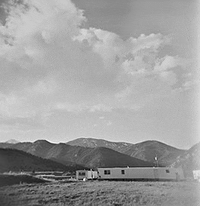
Just as interesting, though again with variation across the state’s counties, is that, according to a 2012 Montana Board of Housing report, just eight percent of manufactured homes are in unacceptable condition, just a tick higher than detached site-built homes, but certainly low enough to counter stereotypes about conditions, quality, or durability. While this report on home conditions is encouraging, it is important to note that other reports, including a recent one from the Harvard Joint Center for Housing Studies, underscore the need for replacement strategies if weatherization or other repair programs are not cost effective.
Earlier this month, I was honored to present on a panel discussing manufactured housing policy, data and, most importantly, preservation, at the Bridging the Gap affordable housing conference in Bozeman, Montana. The conference covered a wide range of housing-related topics—rent reporting for credit building, housing counseling and, of course, manufactured housing. I was joined by Shelia Rice and Kaia Peterson of NeighborWorks Montana, an I’M HOME Lead Organization and leader in working with families to achieve resident ownership to sustain and improve their communities.
One reason why this work is so important—here and in so many other areas—is because housing costs are rising much faster than incomes, often pricing out long-term residents and young families who want to stay in or return to their home towns. For example, the current City of Bozeman’s Affordable Housing Action Plan reports that about half of renters and more than a quarter of owners live in homes they can’t really afford. And, even as we try to make homeownership more accessible in this country, the Bozeman report noted that in recent years, the prices of 80 percent of for sale homes exceeded what was affordable to the median-income earner. This tracks with the stories I heard from local residents, who told me of the burdens they or their families face in the state’s tough housing market. The report also noted that the city needs to develop programs to preserve and improve manufactured housing communities in the area. Perhaps, if done fairly, it can be harnessed in Montana and elsewhere as a full-scale solution.
There’s no doubt that declining federal support for affordable housing continues to hurt, with little relief in sight, and incomes are not rising enough to keep pace with housing prices. Leaders in Bozeman and elsewhere recognize the value of housing stock diversity to address housing needs, and the work to preserve manufactured housing seems to be getting new-found attention.
This sector has, for good reason, gained a lot of attention in recent months; some of it favorable, some of it underscoring the industry’s self-inflicted wounds, reckless policy agenda, and their sometimes off-key and inaccurate responses to media reports.
Despite its name, the Preserving Access to Manufactured Housing Act is not a preservation bill. It is, quite clearly, an industry-driven means to build upon the impressive earnings of the last few years. We should start from the premise that an industry should not write the regulations that governs it. This may be wishful thinking, but it should resonate as we reflect on how the failure to properly regulate home lending brought us the manufactured housing implosion in 1999-2000, as well as the much larger financial crisis eight years later. The bill, thankfully, will not become law, though many in the sector claim it will be enacted, with one industry acolyte oddly asserting that supporters may have to rely on overriding President Obama’s threatened veto.
You would hope (and I hold out this hope) that an industry that continues to do well and offers a low-cost, high-quality product that should serve a growing demand for homeownership, would embrace its strengths in a changing environment. For one, the industry should rethink its sweeping—and doomed—legislation that fails to even address the problem they purport exists. (The industry trade group claims that federal rules have ended loans for less than $20,000, yet have offered legislation that guts them for just about every loan.) The sector instead should focus on new development strategies, on replacement of dilapidated homes and on new lenders to come up with loan products that recognize energy efficiency, land security (through cooperatives or land trusts, for example) and sustainability.
There are ways to do this, and some models in Montana can be shared elsewhere. Working with the Salish & Kootenai Housing Authority of the Flathead Reservation in 2014, NeighborWorks Montana helped preserve 44 homes in Pablo, the first time this was done within the borders of a reservation. Manufactured homes are a key piece of the housing stock on tribal lands in many parts of the country, and we want to learn from and scale the work of that housing authority.
Elsewhere in the state, at Mountain Springs Villa, Inc., in Red Lodge, the cooperative and its development partners secured Rural Development financing for a replacement home on leased land. Many advocates report challenges in working with RD, but at least we know we have the attention of this important agency, and want to advance new ideas on manufactured homes. If leaders want a victory, this accomplishment can be readily replicated.
On small, medium and large scales, CFED and its I’M HOME Network have added credibility to the manufactured housing sector as part of the affordable housing solution. We know that what works in Montana may not work without adjustments in Florida or California. But we also know that manufactured housing is positioned for a rebirth, as long as we’re enabling communities to embrace it, and making sure the industry doesn’t suffocate it.
(Photo: Pam Culver, via Flickr, CC BY-NC-ND 2.0)






Comments